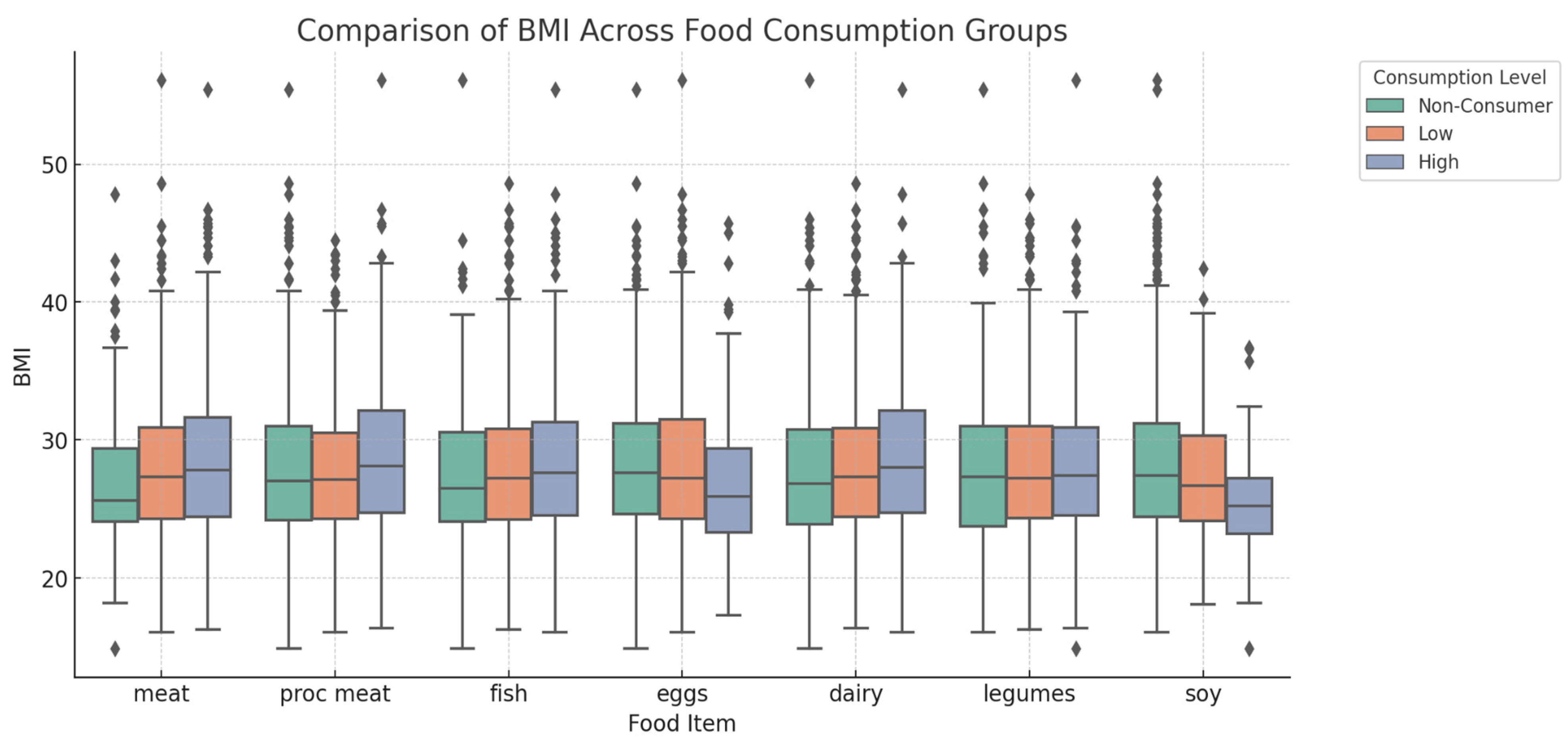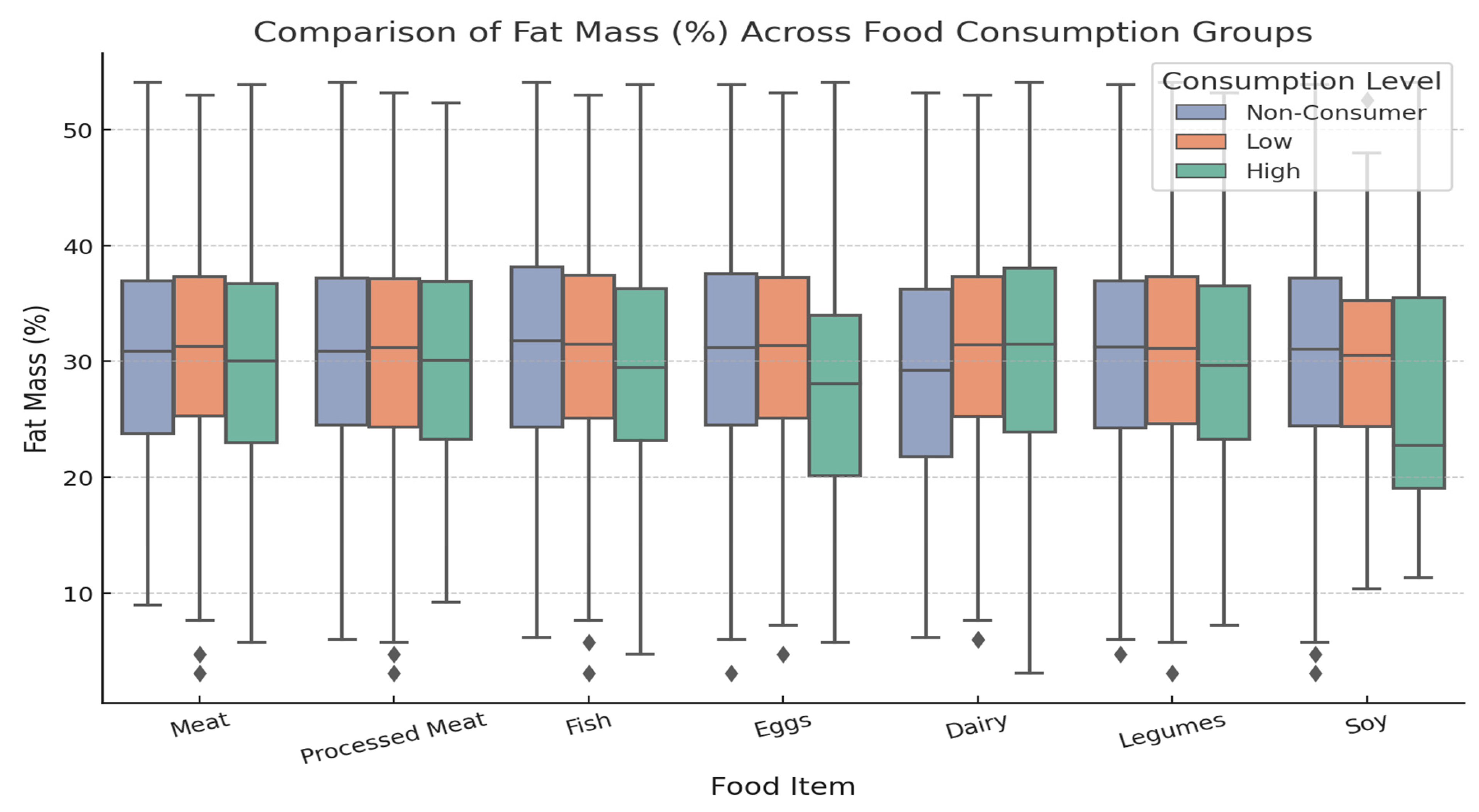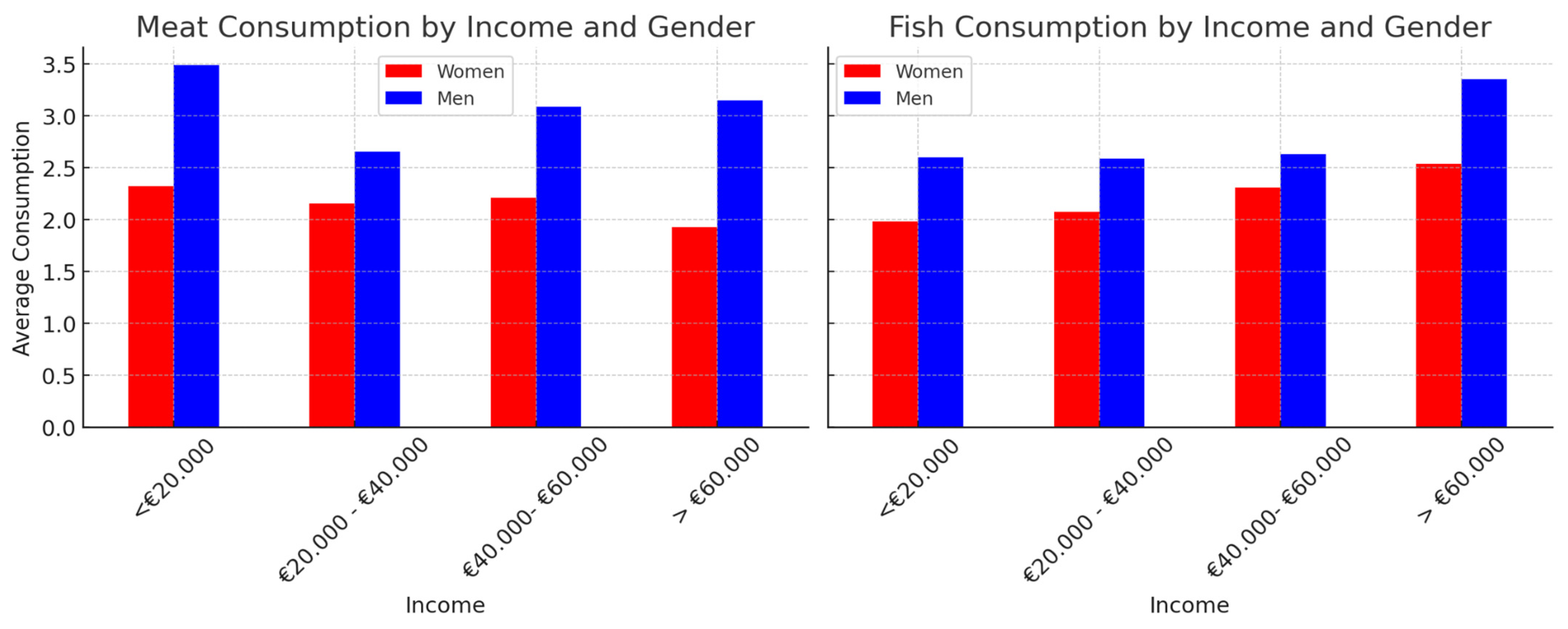Gender Differences in Protein Consumption and Body Composition: The Influence of Socioeconomic Status on Dietary Choices
Abstract
1. Introduction
2. Methods
2.1. Study Design and Participants
2.2. Dietary Assessment
2.3. Body Composition Measurements
2.4. Physical Activity Assessment
2.5. Statistical Analysis
3. Results
4. Discussion
4.1. Gender Differences in Protein Consumption and Body Composition
4.2. Socioeconomic Influence on Protein Choices
4.3. Fish and Dairy Consumption Across Income and Gender
4.4. Cultural Context and Implications for Public Health
4.5. Policy Implications and Future Directions
5. Conclusions
Supplementary Materials
Funding
Institutional Review Board Statement
Informed Consent Statement
Data Availability Statement
Acknowledgments
Conflicts of Interest
References
- De Backer, C.; Erreygers, S.; De Cort, C.; Vandermoere, F.; Dhoest, A.; Vrinten, J.; Van Bauwel, S. Meat and masculinities. Can differences in masculinity predict meat consumption, intentions to reduce meat and attitudes towards vegetarians? Appetite 2020, 147, 104559. [Google Scholar] [CrossRef] [PubMed]
- Nezlek, J.B.; Forestell, C.A. Recent Increases in Vegetarianism may be Limited to Women: A 15-Year Study of Young Adults at an American University. Sex Roles 2024, 90, 1234–1243. [Google Scholar] [CrossRef]
- Feraco, A.; Gorini, S.; Camajani, E.; Filardi, T.; Karav, S.; Cava, E.; Strollo, R.; Padua, E.; Caprio, M.; Armani, A.; et al. Gender differences in dietary patterns and physical activity: An insight with principal component analysis (PCA). J. Transl. Med. 2024, 22, 1112. [Google Scholar] [CrossRef]
- Alkerwi, A.; Vernier, C.; Sauvageot, N.; Crichton, G.E.; Elias, M.F. Demographic and socioeconomic disparity in nutrition: Application of a novel Correlated Component Regression approach. BMJ Open 2015, 5, e006814. [Google Scholar] [CrossRef] [PubMed] [PubMed Central]
- Gonzalgo, M.R.; Nackeeran, S.; Mouzannar, A.; Blachman-Braun, R. Socioeconomic differences associated with consumption of a plant-based diet: Results from the national health and nutrition examination survey. Nutr. Health 2024, 30, 253–259. [Google Scholar] [CrossRef] [PubMed]
- Monterrosa, E.C.; Frongillo, E.A.; Drewnowski, A.; de Pee, S.; Vandevijvere, S. Sociocultural Influences on Food Choices and Implications for Sustainable Healthy Diets. Food Nutr. Bull. 2020, 41 (Suppl. 2), 59S–73S. [Google Scholar] [CrossRef] [PubMed]
- Pechey, R.; Monsivais, P. Socioeconomic inequalities in the healthiness of food choices: Exploring the contributions of food expenditures. Prev. Med. 2016, 88, 203–209. [Google Scholar] [CrossRef] [PubMed] [PubMed Central]
- Camilleri, L.; Kirkovski, M.; Scarfo, J.; Jago, A.; Gill, P.R. Understanding the Meat-Masculinity Link: Traditional and Non-Traditional Masculine Norms Predicting Men’s Meat Consumption. Ecol. Food Nutr. 2024, 63, 355–386. [Google Scholar] [CrossRef]
- Drewnowski, A.; Mognard, E.; Gupta, S.; Ismail, M.; Karim, N.; Tibère, L.; Laporte, C.; Alem, Y.; Khusun, H.; Februhartanty, J.; et al. Socio-Cultural and Economic Drivers of Plant and Animal Protein Consumption in Malaysia: The SCRiPT Study. Nutrients 2020, 12, 1530. [Google Scholar] [CrossRef]
- Bokelmann, W.; Huyskens-Keil, S.; Ferenczi, Z.; Stöber, S. The Role of Indigenous Vegetables to Improve Food and Nutrition Security: Experiences From the Project HORTINLEA in Kenya (2014–2018). Front. Sustain. Food Syst. 2022, 6, 806420. [Google Scholar] [CrossRef]
- Chard, E.; Bergstad, C.; Steentjes, K.; Poortinga, W.; Demski, C. Gender and cross-country differences in the determinants of sustainable diet intentions: A multigroup analysis of the UK, China, Sweden, and Brazil. Front. Psychol. 2024, 15, 1355969. [Google Scholar] [CrossRef] [PubMed]
- Modlińska, K.; Adamczyk, D.; Maison, D.; Pisula, W. Gendesr Differences in Attitudes to Vegans/Vegetarians and Their Food Preferences, and Their Implications for Promoting Sustainable Dietary Patterns—A Systematic Review. Sustainability 2020, 12, 6292. [Google Scholar] [CrossRef]
- Nemec, K. Cultural Awareness of Eating Patterns in the Health Care Setting. Clin. Liver Dis. 2020, 16, 204–207. [Google Scholar] [CrossRef] [PubMed] [PubMed Central]
- Lombardo, M.; Feraco, A.; Camajani, E.; Gorini, S.; Strollo, R.; Armani, A.; Padua, E.; Caprio, M. Effects of Different Nutritional Patterns and Physical Activity on Body Composition: A Gender and Age Group Comparative Study. Foods 2024, 13, 529. [Google Scholar] [CrossRef]
- Castronuovo, L.; Guarnieri, L.; Tiscornia, M.V.; Allemandi, L. Food marketing and gender among children and adolescents: A scoping review. Nutr. J. 2021, 20, 52. [Google Scholar] [CrossRef] [PubMed] [PubMed Central]
- Brunner, E.; Stallone, D.; Juneja, M.; Bingham, S.; Marmot, M. Dietary assessment in Whitehall II: Comparison of 7 d diet diary and food-frequency questionnaire and validity against biomarkers. Br. J. Nutr. 2001, 86, 405–414. [Google Scholar] [CrossRef] [PubMed]
- Callmer, E.; Riboli, E.; Saracci, R.; Akesson, B.; Lindgärde, F. Dietary assessment methods evaluated in the Malmö food study. J. Intern. Med. 1993, 233, 53–57. [Google Scholar] [CrossRef] [PubMed]
- Vasold, K.L.; Parks, A.C.; Phelan, D.M.L.; Pontifex, M.B.; Pivarnik, J.M. Reliability and Validity of Commercially Available Low-Cost Bioelectrical Impedance Analysis. Int. J. Sport Nutr. Exerc. Metab. 2019, 29, 406–410. [Google Scholar] [CrossRef] [PubMed]
- Krakauer, N.Y.; Krakauer, J.C. A new body shape index predicts mortality hazard independently of body mass index. PLoS ONE 2012, 7, e39504. [Google Scholar] [CrossRef]
- Yuan, Y.Q.; Li, F.; Meng, P.; You, J.; Wu, M.; Li, S.G.; Chen, B. Gender Difference on the Association between Dietary Patterns and Obesity in Chinese Middle-Aged and Elderly Populations. Nutrients 2016, 8, 448. [Google Scholar] [CrossRef] [PubMed] [PubMed Central]
- Rizzo, G.; Feraco, A.; Storz, M.A.; Lombardo, M. The role of soy and soy isoflavones on women’s fertility and related outcomes: An update. J. Nutr. Sci. 2022, 11, e17. [Google Scholar] [CrossRef] [PubMed]
- Hamilton-Reeves, J.; Vázquez, G.; Duval, S.; Phipps, W.; Kurzer, M.; Messina, M. Clinical studies show no effects of soy protein or isoflavones on reproductive hormones in men: Results of a meta-analysis. Fertil. Steril. 2010, 94, 997–1007. [Google Scholar] [CrossRef] [PubMed]
- Adamczyk, D.; Modlińska, K.; Maison, D.; Pisula, W. Gender, Masculinity, and the Perception of Vegetarians and Vegans: A Mixed-Methods Investigation. Sex Roles 2023, 89, 595–609. [Google Scholar] [CrossRef]
- Boutros, G.H.; Landry-Duval, M.-A.; Garzon, M.; Karelis, A.D. Is a vegan diet detrimental to endurance and muscle strength? Eur. J. Clin. Nutr. 2020, 74, 1550–1555. [Google Scholar] [CrossRef]
- Evans, E.; Mojtahedi, M.; Thorpe, M.; Valentine, R.; Kris-Etherton, P.; Layman, D. Effects of protein intake and gender on body composition changes: A randomized clinical weight loss trial. Nutr. Metab. 2012, 9, 55. [Google Scholar] [CrossRef]
- Hosseinpour-Niazi, S.; Niknam, M.; Amiri, P.; Mirmiran, P.; Ainy, E.; Izadi, N.; Gaeini, Z.; Azizi, F.; Einy, E. The association between ultra-processed food consumption and health-related quality of life differs across lifestyle and socioeconomic strata. BMC Public Health 2024, 24, 1955. [Google Scholar] [CrossRef]
- Rickerby, A.; Green, R. Barriers to Adopting a Plant-Based Diet in High-Income Countries: A Systematic Review. Nutrients 2024, 16, 823. [Google Scholar] [CrossRef]
- Enriquez, J.P.; Archila-Godinez, J.C. Social and cultural influences on food choices: A review. Crit. Rev. Food Sci. Nutr. 2021, 62, 3698–3704. [Google Scholar] [CrossRef]
- Muhammad, A.; D’Souza, A.; Meade, B.; Micha, R.; Mozaffarian, D. How income and food prices influence global dietary intakes by age and sex: Evidence from 164 countries. BMJ Glob. Health 2017, 2, e000184. [Google Scholar] [CrossRef] [PubMed] [PubMed Central]
- Love, D.C.; Thorne-Lyman, A.L.; Conrad, Z.; Gephart, J.A.; Asche, F.; Godo-Solo, D.; McDowell, A.; Nussbaumer, E.M.; Bloem, M.W. Affordability influences nutritional quality of seafood consumption among income and race/ethnicity groups in the United States. Am. J. Clin. Nutr. 2022, 116, 415–425. [Google Scholar] [CrossRef] [PubMed] [PubMed Central]
- Michaëlsson, K.; Wolk, A.; Langenskiöld, S.; Basu, S.; Warensjö Lemming, E.; Melhus, H.; Byberg, L. Milk intake and risk of mortality and fractures in women and men: Cohort studies. BMJ 2014, 349, g6015. [Google Scholar] [CrossRef] [PubMed] [PubMed Central]
- Willett, W.C.; Ludwig, D.S. Milk and Health. N. Engl. J. Med. 2020, 382, 644–654. [Google Scholar] [CrossRef] [PubMed]
- Zhao, J.; Sun, J.; Su, C. Gender differences in the relationship between dietary energy and macronutrients intake and body weight outcomes in Chinese adults. Nutr. J. 2020, 19, 45. [Google Scholar] [CrossRef] [PubMed]
- Hopwood, C.J.; Zizer, J.N.; Nissen, A.T.; Dillard, C.; Thompkins, A.M.; Graça, J.; Waldhorn, D.R.; Bleidorn, W. Paradoxical gender effects in meat consumption across cultures. Sci. Rep. 2024, 14, 13033. [Google Scholar] [CrossRef]
- Bonaccio, M.; Bonanni, A.; Donati, M.; Gaetano, G.; Iacoviello, L. Information, Culture and Socioeconomics as Determinants of Adherence to Mediterranean Diet. In The Mediterranean Diet; Academic Press: Cambridge, MA, USA, 2015; pp. 589–597. [Google Scholar] [CrossRef]
- Sam-Yellowe, T.Y. Nutritional Barriers to the Adherence to the Mediterranean Diet in Non-Mediterranean Populations. Foods 2024, 13, 1750. [Google Scholar] [CrossRef]
- Amoah, I.; Ascione, A.; Muthanna, F.M.S.; Feraco, A.; Camajani, E.; Gorini, S.; Armani, A.; Caprio, M.; Lombardo, M. Sustainable Strategies for Increasing Legume Consumption: Culinary and Educational Approaches. Foods 2023, 12, 2265. [Google Scholar] [CrossRef]
- Sacchettini, G.; Castellini, G.; Graffigna, G.; Hung, Y.; Lambri, M.; Marques, A.; Perrella, F.; Savarese, M.; Verbeke, W.; Capri, E. Assessing Consumers’ Attitudes, Expectations and Intentions Towards Health and Sustainability Regarding Seafood Consumption in Italy. Sci. Total Environ. 2021, 789, 148049. [Google Scholar] [CrossRef]
- Storz, M.A.; Beckschulte, K.; Brommer, M.; Lombardo, M. Current Sex Distribution of Cooking and Food Shopping Responsibilities in the United States: A Cross-Sectional Study. Foods 2022, 11, 2840. [Google Scholar] [CrossRef]
- Mitsui, T.; Shimaoka, K.; Tsuzuku, S.; Kajioka, T.; Sakakibara, H. Accuracy of body fat assessment by bioelectrical impedance in Japanese middle-aged and older people. J. Nutr. Sci. Vitaminol. 2006, 52, 154–156. [Google Scholar] [CrossRef][Green Version]
- Rech, C.; Glaner, M. Bipolar bioelectrical impedance: Lack of accuracy in estimating relative body fat in men. Braz. J. Kinanthropometry Hum. Perform. 2011, 13, 100–105. [Google Scholar] [CrossRef]
- Liao, Y.S.; Li, H.C.; Lu, H.K.; Lai, C.L.; Wang, Y.S.; Hsieh, K.C. Comparison of Bioelectrical Impedance Analysis and Dual Energy X-ray Absorptiometry for Total and Segmental Bone Mineral Content with a Three-Compartment Model. Int. J. Environ. Res. Public Health 2020, 17, 2595. [Google Scholar] [CrossRef] [PubMed] [PubMed Central]






| Variable | Total (n = 1708) | Male (n = 721) | Female (n = 987) | p-Value | Cohen’s d |
|---|---|---|---|---|---|
| Age (years) | 40.2 ± 14.2 | 39.2 ± 14.1 | 40.9 ± 14.3 | 0.019 | |
| Current Smoker (%) | 22.6% | 21.9% | 23.2% | <0.001 | |
| Weight (kg) | 79.5 ± 17.8 | 88.9 ± 17.7 | 72.7 ± 14.5 | <0.001 | 1.013 |
| BMI (kg/m2) | 28.0 ± 5.2 | 28.7 ± 5.2 | 27.5 ± 5.2 | <0.001 | 0.22 |
| Body Shape Index (BSI) | 0.0811 ± 0.0050 | 0.0815 ± 0.0044 | 0.0815 ± 0.0044 | 0.001 | 0.165 |
| Fat Mass (%) | 30.5 ± 9.1 | 24.8 ± 7.8 | 34.7 ± 7.6 | <0.001 | −1.288 |
| Fat Mass (kg) | 24.8 ± 10.7 | 23.0 ± 11.0 | 26.1 ± 10.4 | <0.001 | −0.287 |
| Fat-Free Mass (%) | 66.0 ± 8.7 | 71.4 ± 7.4 | 62.1 ± 7.3 | <0.001 | 1.272 |
| Fat-Free Mass (kg) | 52.0 ± 11.3 | 62.5 ± 8.6 | 44.3 ± 5.3 | <0.001 | 2.649 |
| Abdominal Circumference (cm) | 96.8 ± 14.3 | 101.1 ± 14.5 | 93.5 ± 13.2 | <0.001 | 0.550 |
| Basal Metabolic Rate (kcal/day) | 1661.1 ± 349.1 | 1963.5 ± 282.2 | 1437.8 ± 188.8 | <0.001 | 2.255 |
| Income (%) | |||||
| <€20,000 | 323 (18.9%) | 125 (17.3%) | 198 (20.1%) | <0.001 | |
| €20,000–€40,000 | 1135 (66.5%) | 484 (67.1%) | 651 (66.0%) | ||
| €40,000–€60,000 | 202 (11.8%) | 91 (12.6%) | 111 (11.2%) | ||
| >€60,000 | 46 (2.7%) | 20 (2.8%) | 26 (2.6%) | ||
| Category Work (%) | |||||
| Sales and Services | 785 (46.0%) | 318 (44.1%) | 467 (47.3%) | <0.001 | |
| Professional Services | 298 (17.4%) | 158 (21.9%) | 140 (14.2%) | ||
| Healthcare and Wellness | 123 (7.2%) | 35 (4.9%) | 88 (8.9%) | ||
| Other | 502 (29.4%) | 210 (29.1%) | 292 (29.6%) | ||
| Do you play a sport? (%) | |||||
| Yes | 931.0 (54.5%) | 440.0 (61.0%) | 491.0 (49.7%) | <0.001 | |
| No | 777.0 (45.5%) | 281.0 (39.0%) | 496.0 (50.3%) | ||
| Sport hours per week (%) | |||||
| <5 h | 687 (40.2%) | 263 (36.5%) | 424 (43.0%) | <0.001 | |
| 5–10 h | 287 (16.8%) | 171 (23.7%) | 116 (11.8%) | ||
| >10 h | 45 (2.6%) | 28 (3.9%) | 17 (1.7%) | ||
| Issue Identified | Policy Recommendation | Target Group |
|---|---|---|
| High meat and processed meat consumption in men | Promote plant-based protein sources through customised campaigns emphasising the benefits for health and muscle performance. | Men, particularly in lower-income groups |
| Socioeconomic disparities in fish consumption | Improving the accessibility and affordability of fresh fish in low-income areas; promoting its role in men’s dietary patterns. | Low-income populations, particularly men |
| Cultural perceptions influencing food choices | Develop communication strategies to counter gender-based food stereotypes and encourage balanced eating patterns. | General population |
| Gender-specific responses to nutritional messaging | Designing targeted interventions: performance and strength messages for men, longevity and sustainability for women. | Men and women |
| Misconceptions about plant-based proteins in men | Designing targeted interventions: performance and strength messages for men, longevity and sustainability for women. | Men, especially those engaged in physical activity |
Disclaimer/Publisher’s Note: The statements, opinions and data contained in all publications are solely those of the individual author(s) and contributor(s) and not of MDPI and/or the editor(s). MDPI and/or the editor(s) disclaim responsibility for any injury to people or property resulting from any ideas, methods, instructions or products referred to in the content. |
© 2025 by the author. Licensee MDPI, Basel, Switzerland. This article is an open access article distributed under the terms and conditions of the Creative Commons Attribution (CC BY) license (https://creativecommons.org/licenses/by/4.0/).
Share and Cite
Lombardo, M. Gender Differences in Protein Consumption and Body Composition: The Influence of Socioeconomic Status on Dietary Choices. Foods 2025, 14, 887. https://doi.org/10.3390/foods14050887
Lombardo M. Gender Differences in Protein Consumption and Body Composition: The Influence of Socioeconomic Status on Dietary Choices. Foods. 2025; 14(5):887. https://doi.org/10.3390/foods14050887
Chicago/Turabian StyleLombardo, Mauro. 2025. "Gender Differences in Protein Consumption and Body Composition: The Influence of Socioeconomic Status on Dietary Choices" Foods 14, no. 5: 887. https://doi.org/10.3390/foods14050887
APA StyleLombardo, M. (2025). Gender Differences in Protein Consumption and Body Composition: The Influence of Socioeconomic Status on Dietary Choices. Foods, 14(5), 887. https://doi.org/10.3390/foods14050887








